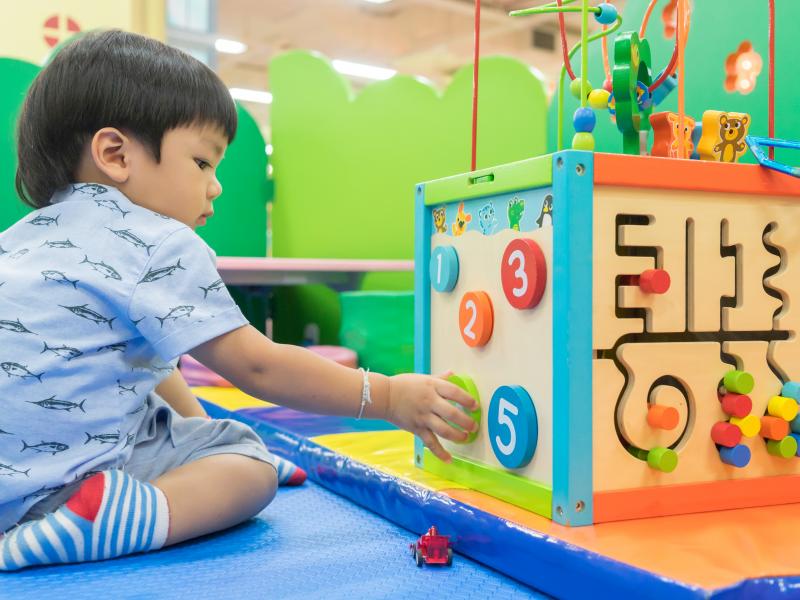Math is everywhere! From the spatial reasoning we use as we drive to work to estimating the tip at lunch, math and math skills are part of our everyday lives. In early childhood, these kinds of daily connections make new concepts and skills easier to learn. Simple activities like having to sort toys into bins based on type or count out equal numbers of crackers at snack time allow children to practice math concepts directly, but there are other ways to incorporate these skills into lessons in science, engineering, and even literacy.
Creative Investigations in Early Math, by Angela Eckhoff, provides teachers and caregivers with activities that easily bring in other classroom subjects into math lessons. Whether it’s adding a bit of physical movement to an activity or combining numbers with the classroom’s book of the week, Creative Investigations offers dozens of ideas to expand lessons beyond traditional counting. Below are a few activities to bring other topics into the Math Station.
Jumping Numbers Game
Objective:
Children will identify numbers rolled on a six-sided dice while staying active by hopping the proper number of spaces.
Materials:
What to Do:
- Before beginning play, talk with the children about the dice. Invite them to examine a die and see how each of the six faces shows a different number of dots. Ask them to count the number of dots on each side with you
- Have the children stand a few feet away from the number line
- Ask the child to roll a die and watch to see which side lands facing up. That is the number he will need to jump to on the number line and then stand in that box until the next number is rolled. If playing in small groups, the children will need to take turns rolling a die and counting
- Encourage the children to count together and help the player jump to the corresponding number on the number line
Adding to the Story
Objective:
Children will describe changes that occur in a group when more objects are added to a group or combined together by looking at groups of numbered items in a story
Materials:
What to Do:
- Start the activity by drawing a character or a few characters on drawing paper or a whiteboard, or using felt characters on a felt board. Ask the children to count how many characters are shown
- Begin to tell the story, and then ask a child to share what happens next
- If this is a first-time experience, it can help the children to begin with a familiar story and modify it as the activity moves along. A story such as “The Three Little Pigs” or “Snow White and the Seven Dwarves” can provide an easy starting point because groups of objects are central to these stories. For example, you could begin “The Three Little Pigs” by drawing the pigs or using felt characters. Ask the children to count the pigs. You could change up the familiar story by adding in two piggy cousins to the story’s cast of characters. Draw two new characters to add to the group of three. Ask the children to count the number of pigs again
- Emphasize the mathematics language of more or fewer. Continue with the story. Invite children to add in new characters or remove characters from the story in their storytelling. Be sure to pause the story where necessary to conduct a new character count
2-D to 3-D Shape Making
Objective:
Children will recognize shapes and gain an understanding of how 2-D shapes come together to form 3-D shapes, developing spatial awareness and design skills
Materials:
What to Do:
- As you support children’s efforts during the activity, explain the following terms related to 3-D shapes:
- The base forms the bottom of the shape and supports the structure
- Faces are the flat parts of the shape
- Edges are the lines where two faces meet
- Vertices are the points where two or more edges meet
- Encourage the children to begin by making fifteen to twenty small clay balls (approximately 2 centimeters in diameter). For safety reasons, make sure the balls are not small enough to be choking hazards. Each child will need enough clay balls to create multiple shapes. The balls will connect the toothpicks, which form the edges of a square. When making a cube from a square, a child will need a total of twelve toothpicks and eight clay balls
- Ask each child to pick a 3-D shape to create. Once a shape is chosen, ask each child what 2-D shape looks like part of the 3-D shape. Encourage the children to use the 3-D shape blocks support their thinking
- Once they have determined the 3-D shape, they are ready to begin creating the 2-D shape. As they build on the 2-D shape, they will need your help holding pieces in place until the sides of the shape support the weight of the piece
- Take photographs of the finished models and keep them as blueprints, keepsakes, or other documentation

